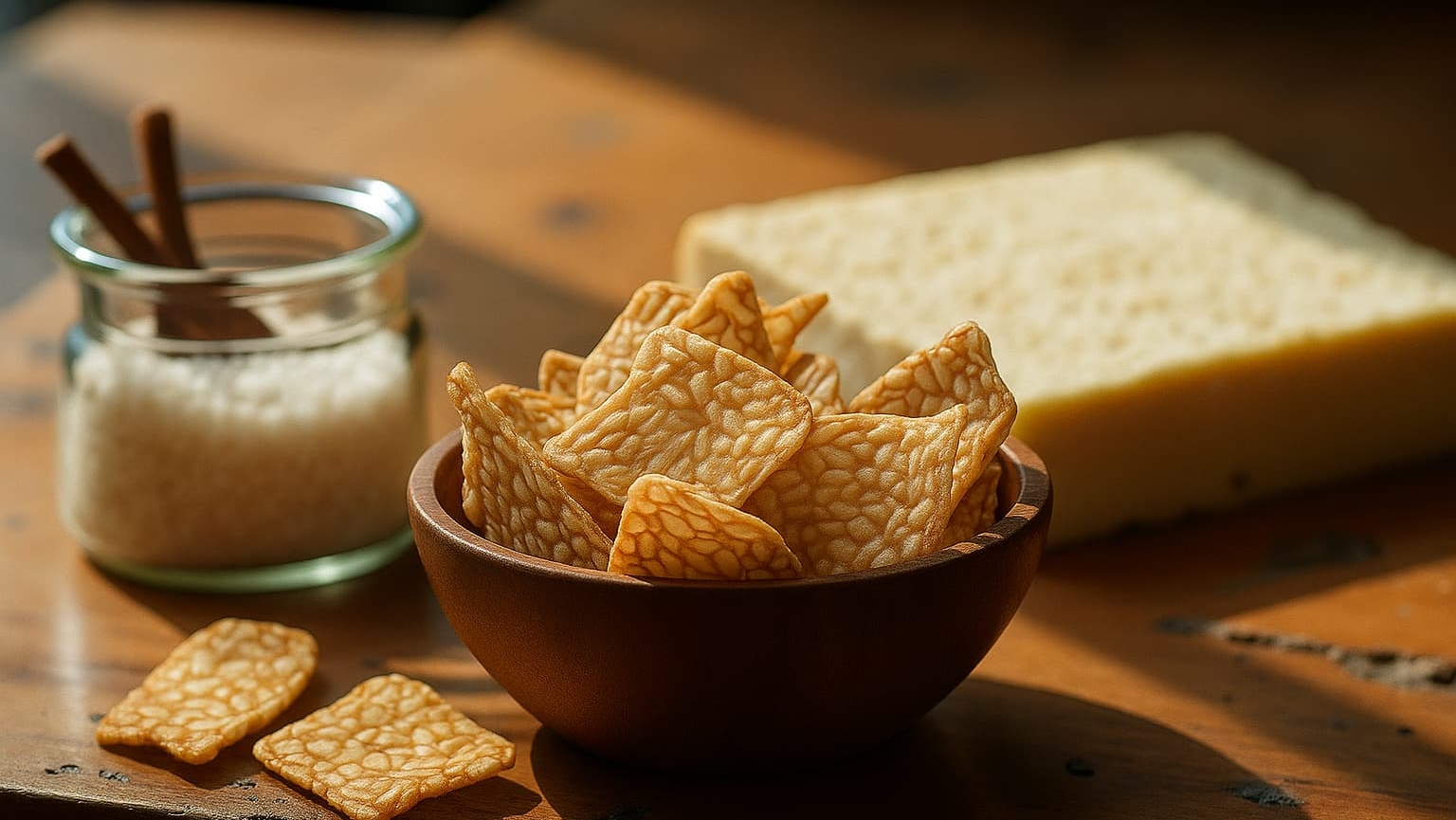The salt level hits just right, bringing out the nutty, fermented soybean flavor without going overboard. At SoyaMaya, they’re working with Indiana farmers who get this balance. It’s honestly fascinating how the natural umami from fermentation plays with just a touch of sea salt, creating something that doesn’t leave you desperately reaching for water.
Sure, it’s different from the typical chip experience, but that’s what makes these snacks worth a try. Want to know what makes these chips truly stand out? Keep reading to discover why they’re becoming everyone’s new favorite snack.
Key Takeaway
- Tempeh chips have a mild saltiness, usually around 120 to 150 mg of sodium per serving.
- The fermentation process adds natural umami and subtle salty notes, complementing light sea salt seasoning.
- Compared to traditional tempeh chips, tempeh chips offer a less greasy, lower-sodium, plant-based snack option.
Tempeh Chips Saltiness Level: Understanding Salt Content in Tempeh Chips
What is the Saltiness Level of Tempeh Chips?
Anyone who’s tried tempeh chips probably noticed they don’t blast your taste buds with salt like those neon-orange cheese puffs do pair with sea salt chips.
A handful of these Indonesian-style chips pack about 120 to 150 mg of sodium per serving (that’s about what you’d get if you pinched some salt between two fingers and dropped it on your food). They’re salty enough to be satisfying, but you won’t be reaching for your water glass after every bite.
The salt story gets interesting because these chips don’t just get their flavor from the shaker. The whole fermentation thing that tempeh goes through naturally creates this savory, kind of salty taste – a process that Indonesian cooks have been working with for hundreds of years.
Makes sense when you think about it – fermented foods usually have that subtle salty kick to them, and tempeh’s no different. Pretty neat how nature does some of the seasoning work on its own.
Sodium Content per Serving in Tempeh Chips
Here’s a surprising fact – tempeh chips only pack around 120 to 150 milligrams of sodium in each serving. Compare that to those bags of regular potato chips sitting in everyone’s pantry, loaded with 200+ milligrams of sodium per handful. Not bad for a snack that’s actually pretty tasty. And yeah, for anyone keeping track of their salt (like most of us probably should), these chips won’t wreck your daily numbers.
How Fermentation Influences Saltiness in Tempeh Chips
The peculiar tang of tempeh starts long before it hits the fryer. When Rhizopus oligosporus (that’s the mold that does all the work) gets going on those soybeans, it breaks them down into something totally different – firmer, meatier, and yeah, kind of salty even though nobody’s added salt yet.
The folks at SoyaMaya probably figured this out years ago, which might explain why their chips don’t need much extra salt. Just a sprinkle of sea salt at the end, and that’s it. Pretty clever when you think about it. The natural fermentation does most of the heavy lifting, creating this built-in savory kick that’s hard to describe but definitely there.
How Does Flavor Balance Affect Tempeh Chips’ Saltiness?

Nutty Flavor Attributes of Tempeh Chips
The nutty undertones of tempeh chips might be the first thing you’d notice, probably because of the way those soybeans get broken down during fermentation. When you bite into one, there’s this back-and-forth between the salt and that earthy nuttiness – kind of like they’re working together instead of fighting for attention.
The best batches (around 1.5% salt by weight) let those natural flavors do their thing, and you’ll catch yourself reaching for another handful before you know it. The fermentation process usually takes about 24 hours at 88°F, but that’s just the nerdy detail behind why these chips taste so darn good.
Sea Salt Usage in Tempeh Chips
Salt from the sea probably sounds fancy, but that’s what makes these tempeh chips work. When they’re fresh out of the fryer, hot and crackling, the sea salt flavor hits just right. No need to get complicated – a pinch or two (about 1/4 teaspoon per cup) is enough to make the nutty tempeh taste pop.
The crystals stick to the golden surface, and that’s really all you need. None of those weird flavor powders or mystery seasonings, because honestly, good tempeh doesn’t need the help. Just that subtle crunch of salt against the crispy chip, and you’re there.
Comparison of Tempeh Chips to Traditional Chips
Anyone who’s dug into a bag of tempeh chips might notice something different right away – there’s none of that familiar grease stain on your fingers that regular potato chips leave behind. The salt doesn’t hit you over the head either, it’s just there in the background doing its job.
These chips aren’t trying to be fancy, they’re just doing their own thing with their plant protein (about 15 grams per serving). Not that they’re perfect or anything, but they definitely don’t give you that “I need water right now” feeling that comes after demolishing half a bag of regular chips.
Variations in Saltiness Across Brands and Preparation Methods
Salt levels bounce around quite a bit in tempeh chips. You’ll find some with just a sprinkle, others completely plain, and a handful that mix things up with paprika or garlic powder thrown in.
The folks at SoyaMaya don’t mess around – they stick to good old sea salt, probably because that’s how it’s been done forever. And instead of dunking the chips in hot oil, they blast them with hot air until they get those crispy edges everyone’s after. Makes for a lighter snack that won’t leave your fingers greasy. A bit pricey maybe, but that’s what you get with small batch stuff.
What Are the Health Implications of Salt in Tempeh Chips?

Sodium Levels Compared to Regular Potato Chips
Numbers don’t lie when it comes to salt, and tempeh chips might be onto something here. Your average bag of potato chips probably has enough sodium to make your doctor wince – we’re talking about 170mg per ounce. But tempeh chips? They’ve managed to keep things in check, usually hanging around 95mg per ounce (though brands vary).
That’s a pretty big difference for anyone who’s ever demolished half a bag of chips during movie night. The nice thing about tempeh chips is you can actually taste the nutty flavors instead of just salt, salt, and more salt. Not exactly rocket science, but definitely worth thinking about next time you’re reaching for a snack.
Tempeh Chips as a Plant-Based High-Protein Snack
That salty crunch might hook snackers first, but tempeh chips pack way more than just flavor. These crispy bites (made from soybeans that’ve been fermented) bring about 15 grams of protein per serving to the table. Nobody’s gonna turn down a snack that tastes good and keeps their stomach from growling an hour later.
Health food stores can’t seem to keep them in stock these days, probably because people are catching on that they don’t have to choose between something that tastes good and something that’s actually decent for them.
Availability of Unsalted Tempeh Chips
Unsalted tempeh chips aren’t exactly common at most stores, but you can find them if you look hard enough. They’re basically blank canvases – perfect for people who want to doctor up their snacks with their own seasonings or dips.
For anyone watching their salt intake (and there’s probably more of us who should be), these chips might be worth tracking down. Plus, they don’t taste half bad straight out of the bag, just different from what most people expect from a chip.
Reading Nutrition Labels for Salt Content Awareness
Salt’s hiding everywhere, but checking labels makes it pretty simple to track. The milligrams of sodium per serving might shock you – different brands of the same food can pack wildly different amounts (sometimes up to 400mg difference in a single serving).
Even home recipes for things like tomato sauce might range from 120mg to 600mg per cup. The smart move? Just flip the package over and scan that nutrition panel. No mysteries, no surprises. Just numbers that tell you what you need to know (1).
How to Choose and Enjoy Tempeh Chips Based on Saltiness

Selecting Tempeh Chips by Salt Level
Most people don’t think about salt levels when they grab a bag of tempeh chips off the shelf, but it’s probably the first thing they should check. Some brands pack in about 400mg of sodium per serving – that’s like eating a small bag of potato chips.
The light salt versions usually cut that down to around 200mg, which might work better for someone watching their salt. And there’s always those plain ones sitting on the bottom shelf, just waiting for someone to take them home and season them up themselves. Sometimes that’s the way to go. Makes the whole snacking thing more personal, you know?
Pairing Tempeh Chips with Dips or Seasonings
These fermented soy chips might seem bland at first bite. No worries though – a splash of fresh squeezed lime or a quick dunk in some soy sauce brings them right to life.
Most people swear by sprinkling some nutritional yeast on top (that yellow flaky stuff you’ll find in health food stores), which adds this weirdly addictive cheesy taste. Just throw on whatever flavors you’re craving, since tempeh chips kinda act like a blank canvas for seasonings.
Using Tempeh Chips in Recipes
These little salty crunchers do wonders sprinkled over a bowl of greens or floating on hot soup. Not too strong, not too weak – just right.
They’re pretty adaptable too, kinda like the potato chip’s sophisticated cousin who went to college. Their subtle nutty flavor (from the fermented soybeans) makes them play nice with almost anything you throw them on. Perfect when you need that crunch factor but don’t want to drown out the main dish.
Tips to Balance Salt Intake When Eating Tempeh Chips
Tempeh chips pack a salty punch, but they don’t have to throw off your daily sodium numbers. Grab a handful (about 1 oz or 28g) and mix them with cucumber slices or carrot sticks, these fresh sides balance things out pretty well.
Ranch dip might be tempting, but try mashing up half an avocado instead. Keep the portions reasonable. Maybe split a bag into smaller zip-locks right when you buy them, that way you won’t mindlessly munch through the whole thing while watching TV. Some people who watch their blood pressure (anything over 130/80 mm Hg) might want to stick to just a few chips at a time.
FAQ
Are tempeh chips sea salt snacks really salty, and how do they compare with other fermented foods or soy products?
These chips don’t smack you in the face with salt like regular potato chips do. Each bite brings out this earthy, kind of nutty flavor from the fermented soybeans – the sea salt tempeh chips taste balanced, never overpowering, and just enough to make the nuttiness pop.
They’re a lot different from other fermented stuff, and they’re definitely not as greasy as most soy snacks you’ll find at the store. Just right for munching.
Do tempeh chips offer health benefits, and can they affect cholesterol levels or oxidative stress?
There’s some good stuff going on with these chips. The fermented soybeans pack about 15 grams of protein per serving, plus those soy compounds (isoflavones) that scientists keep talking about. Research points to soy helping with cholesterol, and yeah, it might fight off cell damage too. They’re still fried snacks, but they’re probably better for you than those cheese puffs sitting in your pantry.
How does making tempeh with rhizopus oligosporus and a tempeh starter influence shelf life and flavor in tempeh chips?
The whole thing starts with this fungus (rhizopus oligosporus, if you’re getting technical) that turns soybeans into tempeh. It’s what gives these chips their nutty kick and that satisfying crunch. Don’t freak out about storage – just keep them in a sealed container at room temp, and they’ll stay crispy for weeks. Not that they usually last that long.
Are tempeh chips gluten free, and do they still give the same vitamins and minerals as other soy protein foods?
Most brands don’t mess with gluten, though some throw in rice flour for extra crunch. You’re still getting decent nutrition – each handful’s got iron, calcium, and all that good soy protein (about 8-10 grams per serving). Sure, frying them takes away some of the healthy stuff, but they beat regular chips by a mile (2).
What role do coconut milk and sea salt play in flavoring tempeh chips from central java, and how do these soy products fit into gift box traditions?
Tempeh chips have deep roots in Central Java, where makers often add coconut milk and just enough sea salt to bring out the flavors. Soya Maya keeps that same tradition alive in Indiana, blending Indonesian heritage with Midwest-grown soybeans.
Conclusion
In Greensburg, Indiana, Mayasari Effendi’s Soya Maya tempeh chips bring something special to the snack aisle. These aren’t your average potato chips – they’re a plant-based treat that packs real flavor without the guilt.
Made from local non-GMO soybeans and seasoned just right, these crispy bites carry both Indonesian tradition and Midwest farming pride in every crunch. The fresh-fermented tempeh base gives them a nutty, satisfying taste that’s different from anything you’ve probably tried before.
Grab your tempeh chips and support local farming
References
- https://www.nutritionvalue.org/public_recipe_172933.html
- https://www.healthline.com/nutrition/tempeh

